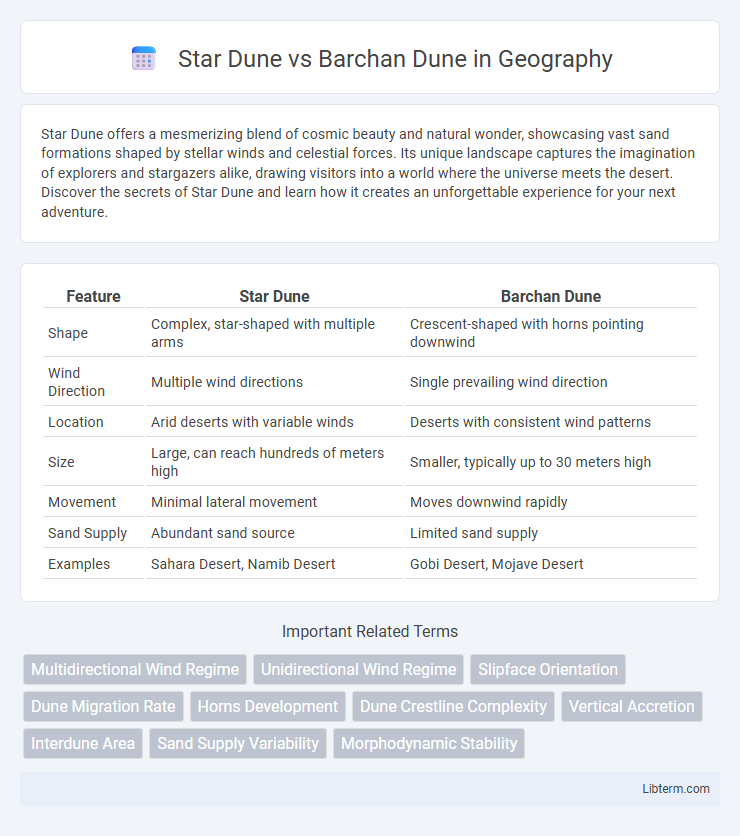Star Dune offers a mesmerizing blend of cosmic beauty and natural wonder, showcasing vast sand formations shaped by stellar winds and celestial forces. Its unique landscape captures the imagination of explorers and stargazers alike, drawing visitors into a world where the universe meets the desert. Discover the secrets of Star Dune and learn how it creates an unforgettable experience for your next adventure.
Table of Comparison
| Feature | Star Dune | Barchan Dune |
|---|---|---|
| Shape | Complex, star-shaped with multiple arms | Crescent-shaped with horns pointing downwind |
| Wind Direction | Multiple wind directions | Single prevailing wind direction |
| Location | Arid deserts with variable winds | Deserts with consistent wind patterns |
| Size | Large, can reach hundreds of meters high | Smaller, typically up to 30 meters high |
| Movement | Minimal lateral movement | Moves downwind rapidly |
| Sand Supply | Abundant sand source | Limited sand supply |
| Examples | Sahara Desert, Namib Desert | Gobi Desert, Mojave Desert |
Introduction to Sand Dune Types
Star dunes form from multidirectional wind patterns, resulting in complex, pyramid-shaped mounds with multiple arms extending from a central peak. Barchan dunes develop in environments with unidirectional winds and limited sand supply, creating crescent-shaped ridges with horns pointing downwind. These two dune types illustrate the influence of wind variability and sand availability on desert landscape formation.
What is a Star Dune?
A Star Dune is a large, pyramid-shaped sand formation characterized by multiple arms or ridges extending from a central peak, formed in areas with multidirectional wind patterns. These complex dunes grow vertically due to sand accumulation from varying wind directions, distinguishing them from simpler dune types like the Barchan Dune, which has a crescent shape and forms under unidirectional winds. Star Dunes are prominent in deserts such as the Grand Erg Oriental in Algeria and the Sahara, where wind variability creates their unique morphology.
What is a Barchan Dune?
A Barchan dune is a crescent-shaped sand formation typically found in desert regions with a unidirectional wind regime and limited sand supply. Its horns point downwind, indicating the prevailing wind direction, and the dune migrates as sand is pushed over the crest. Compared to complex star dunes, Barchan dunes are simpler in structure and form under consistent wind conditions.
Formation Processes: Star vs Barchan Dunes
Star dunes form through multidirectional wind patterns that cause sand to accumulate around a central peak, resulting in a complex, star-shaped structure with multiple arms. Barchan dunes develop in environments with a unidirectional wind regime and limited sand supply, forming crescent-shaped ridges with horns pointing downwind. The key difference lies in wind direction variability: star dunes require multidirectional winds for their intricate shapes, while barchan dunes form under steady, single-direction winds creating simpler, crescent forms.
Distinctive Shapes and Structures
Star dunes feature multiple arms radiating from a central peak, creating a complex, star-like shape formed by multidirectional wind patterns. Barchan dunes display a crescent shape with a gentle wind-facing slope and steep slip faces on the horns, shaped by unidirectional winds in sandy, arid environments. The structural complexity of star dunes contrasts with the simpler, mobile form of barchan dunes, resulting in varied sand movement and dune stability.
Environmental Conditions and Locations
Star dunes form in environments with multidirectional wind regimes, commonly found in desert regions like the Sahara and Arabian deserts, where varied wind directions create complex dune shapes. Barchan dunes develop in areas with unidirectional winds and limited sand supply, typical in arid climates such as the Gobi Desert and parts of the southwestern United States. Star dunes indicate significant wind variability and high sand accumulation, whereas barchan dunes suggest consistent wind patterns and more mobile sand.
Wind Patterns and Their Effects
Star dunes form in multidirectional wind environments where varying wind directions cause sand to accumulate around a central peak, resulting in a complex, star-shaped pattern. In contrast, barchan dunes develop in regions with unidirectional wind flow, causing sand to pile into crescent shapes with horns pointing downwind. The wind patterns directly influence dune morphology, with star dunes indicating variable and shifting winds, while barchans reflect steady, consistent wind directions.
Ecological Significance and Adaptations
Star dunes, characterized by multiple arms radiating from a central peak, create diverse microhabitats that support varied plant and animal species adapted to shifting sands and harsh conditions. Barchan dunes, crescent-shaped and formed by unidirectional winds, serve as key ecosystems for specialized flora and fauna adapted to their stable leeward sides and dynamic windward slopes. Both dune types contribute to soil stabilization, water retention, and serve as natural barriers against desertification, playing critical roles in maintaining desert biodiversity and ecological resilience.
Human Interactions and Impacts
Star dunes, with their complex, multi-armed structure, often form in regions with variable wind directions, leading to more stable landscapes that can support human activities such as agriculture and settlement. Barchan dunes, characterized by their crescent shape and unidirectional winds, tend to migrate rapidly, posing significant risks to infrastructure, roads, and arable land in desert regions. Human interventions like vegetation planting and dune stabilization efforts are more effective on the slower-moving star dunes, while managing barchan dunes requires ongoing efforts to mitigate sand encroachment and protect communities.
Summary of Key Differences
Star dunes feature multiple slip faces radiating from a central peak formed by multidirectional winds, while barchan dunes have a crescent shape with horns pointing downwind, shaped by unidirectional winds. Star dunes tend to be taller and more stable due to their complex wind patterns, whereas barchan dunes migrate faster across desert surfaces. Barchan dunes are common in areas with limited sand supply, whereas star dunes accumulate larger sand volumes in wind regimes with varying directions.
Star Dune Infographic

 libterm.com
libterm.com